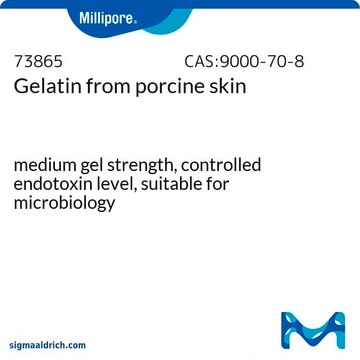48722
Gelatin from porcine skin
medium gel strength, suitable for microbiology
Synonyme(s) :
Gelatine, hydrolyzed collagen, collagen hydrolysate, gelatine hydrolysate
About This Item
Produits recommandés
Source biologique
Porcine
Niveau de qualité
Stérilité
non-sterile
Forme
powder
Qualité
medium gel strength
Conditionnement
bottle of 100 g
bottle of 500 g
Résidus de calcination
≤2%
Perte
≤15% loss on drying
Couleur
light yellow
pH
4.0-6.0 (25 °C, 67 mg/mL in H2O)
Résistance du gel
165-195 g Bloom (67 mg/ml water)
Solubilité
H2O: 67 mg/mL at 50 °C, slightly hazy, slightly yellow
Traces d'anions
chloride (Cl-): ≤3000 mg/kg
Traces de cations
Ca: ≤2000 mg/kg
Cd: ≤5 mg/kg
Co: ≤5 mg/kg
Cr: ≤10 mg/kg
Cu: ≤50 mg/kg
Fe: ≤50 mg/kg
K: ≤500 mg/kg
Mg: ≤500 mg/kg
Mn: ≤5 mg/kg
Na: ≤5000 mg/kg
Ni: ≤5 mg/kg
Pb: ≤5 mg/kg
Zn: ≤10 mg/kg
Application(s)
microbiology
Vous recherchez des produits similaires ? Visite Guide de comparaison des produits
Catégories apparentées
Description générale
Gelatin is a heterogeneous mixture of water-soluble proteins of high average molecular masses present in collagen. Proteins are extracted by boiling the relevant skin, tendons, ligaments, bones, etc., in water. Type A gelatin is derived from acid-cured tissue, and Type B from lime-cured tissue.
The Bloom number, determined by the Bloom gelometer, is an indication of the strength of a gel formed from a solution of the known concentration. The Bloom number is proportional to the average molecular mass. Bloom numbers of porcine skin Gelatin vary from 90 to 300 g. This product has a gel strength of 180.
Application
Composants
Attention
Notes préparatoires
Code de la classe de stockage
11 - Combustible Solids
Classe de danger pour l'eau (WGK)
nwg
Équipement de protection individuelle
Eyeshields, Gloves, type N95 (US)
Choose from one of the most recent versions:
Déjà en possession de ce produit ?
Retrouvez la documentation relative aux produits que vous avez récemment achetés dans la Bibliothèque de documents.
Les clients ont également consulté
Notre équipe de scientifiques dispose d'une expérience dans tous les secteurs de la recherche, notamment en sciences de la vie, science des matériaux, synthèse chimique, chromatographie, analyse et dans de nombreux autres domaines..
Contacter notre Service technique









